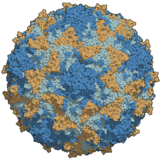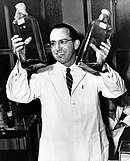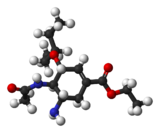Portal:Viruses
The Viruses Portal
Welcome!

Viruses are small infectious agents that can replicate only inside the living cells of an organism. Viruses infect all forms of life, including animals, plants, fungi, bacteria and archaea. They are found in almost every ecosystem on Earth and are the most abundant type of biological entity, with millions of different types, although only about 6,000 viruses have been described in detail. Some viruses cause disease in humans, and others are responsible for economically important diseases of livestock and crops.
Virus particles (known as virions) consist of genetic material, which can be either DNA or RNA, wrapped in a protein coat called the capsid; some viruses also have an outer lipid envelope. The capsid can take simple helical or icosahedral forms, or more complex structures. The average virus is about 1/100 the size of the average bacterium, and most are too small to be seen directly with an optical microscope.
The origins of viruses are unclear: some may have evolved from plasmids, others from bacteria. Viruses are sometimes considered to be a life form, because they carry genetic material, reproduce and evolve through natural selection. However they lack key characteristics (such as cell structure) that are generally considered necessary to count as life. Because they possess some but not all such qualities, viruses have been described as "organisms at the edge of life".
Selected disease
Smallpox is an eradicated infectious disease of humans caused by the Variola major and V. minor viruses. V. major causes a serious disease with a mortality rate of around 30%; V. minor is associated with much milder symptoms and mortality below 1%. The virus is mainly transmitted by the respiratory route but can also be carried on contaminated objects. Smallpox preferentially infects skin cells, resulting in a usually maculopapular rash, and later, raised fluid-filled blisters. Most V. major survivors have permanent scarring, commonly on the face, which can be extensive. Less common long-term complications include blindness resulting from corneal ulceration and scarring, and in young children, limb deformities due to arthritis and osteomyelitis.
Smallpox probably emerged in human populations in about 10,000 BC; the mummified body of Egyptian pharaoh Ramses V shows evidence of smallpox rash. The disease was responsible for an estimated 300–500 million deaths during the 20th century. Smallpox vaccine, the earliest vaccine, was developed in the 18th century. After intensive vaccination campaigns, the last natural infection occurred in 1977. Smallpox was certified the first infectious disease to be eradicated globally in 1979. Debate is ongoing over whether all stocks of the virus should be destroyed.
Selected image
HIV-1 budding from lymphocytes in culture. HIV establishes a latent infection in several types of immune cell and causes profound immunodeficiency.
Credit: C. Goldsmith (1984)
In the news
26 February: In the ongoing pandemic of severe acute respiratory syndrome coronavirus 2 (SARS-CoV-2), more than 110 million confirmed cases, including 2.5 million deaths, have been documented globally since the outbreak began in December 2019. WHO
18 February: Seven asymptomatic cases of avian influenza A subtype H5N8, the first documented H5N8 cases in humans, are reported in Astrakhan Oblast, Russia, after more than 100,0000 hens died on a poultry farm in December. WHO
14 February: Seven cases of Ebola virus disease are reported in Gouécké, south-east Guinea. WHO
7 February: A case of Ebola virus disease is detected in North Kivu Province of the Democratic Republic of the Congo. WHO
4 February: An outbreak of Rift Valley fever is ongoing in Kenya, with 32 human cases, including 11 deaths, since the outbreak started in November. WHO
21 November: The US Food and Drug Administration (FDA) gives emergency-use authorisation to casirivimab/imdevimab, a combination monoclonal antibody (mAb) therapy for non-hospitalised people twelve years and over with mild-to-moderate COVID-19, after granting emergency-use authorisation to the single mAb bamlanivimab earlier in the month. FDA 1, 2
18 November: The outbreak of Ebola virus disease in Équateur Province, Democratic Republic of the Congo, which started in June, has been declared over; a total of 130 cases were recorded, with 55 deaths. UN
Selected article
A global drive to eradicate poliovirus started in 1988, when there were an estimated 350,000 cases of wild poliovirus infection globally. Two diseases, both caused by viruses, have been eradicated, smallpox in 1980 and rinderpest in 2011. Poliovirus only infects humans. It persists in the environment for a few weeks at room temperature and a few months at 0–8 °C. The oral polio vaccine is inexpensive, highly effective and is predicted to generate lifelong immunity. Reversion of live vaccine strains to virulence has resulted in occasional cases of vaccine-associated polio paralysis.
Two of the three strains of wild-type poliovirus have been eradicated. Annual reported cases of wild poliovirus infection fell to a low of 22 in 2017, but had risen to 176 in 2019. As of 2020, the wild virus remains endemic only in Afghanistan and Pakistan, but vaccine-derived poliovirus is circulating in several countries. A lack of basic health infrastructure and civil war remain significant obstacles to eradication. Some local communities have opposed immunisation campaigns, and vaccination workers have been murdered in Pakistan and Nigeria.
Selected outbreak
In the severe acute respiratory syndrome (SARS) outbreak, the first cases of the newly emerged SARS coronavirus were reported in November 2002 from the Chinese Guangdong province. The virus soon spread across Asia, with China, Hong Kong, Taiwan and Singapore being the worst affected countries; a secondary outbreak occurred in Canada. The rapid initial spread of the outbreak has been in part attributed to China's slow response to the early cases. Over 8,000 people were infected, with a case fatality rate of 11%. Those over 65 years had a much higher mortality rate, greater than 55%. The outbreak was contained by July 2003, and no cases have been reported since 2004.
At the time of the outbreak, the immediate source of SARS coronavirus was thought to have been the masked palm civet (Paguma larvata; pictured), which was sold as food in Guangdong markets. The virus was also found in raccoon dogs, ferret badgers and domestic cats. More recent research has suggested that the natural reservoir could be horseshoe bats.
Selected quotation
| “ | To help conceptualize the sheer number of viruses in existence, their current biomass has been estimated to equal that of 75 million blue whales (approximately 200 million tonnes) and, if placed end to end, the collective length of their virions would span 65 galaxies. | ” |
—Peter Simmonds
Recommended articles
Viruses & Subviral agents: bat virome • elephant endotheliotropic herpesvirus • HIV • introduction to viruses![]() • Playa de Oro virus • poliovirus • prion • rotavirus
• Playa de Oro virus • poliovirus • prion • rotavirus![]() • virus
• virus![]()
Diseases: colony collapse disorder • common cold • croup • dengue fever![]() • gastroenteritis • Guillain–Barré syndrome • hepatitis B • hepatitis C • hepatitis E • herpes simplex • HIV/AIDS • influenza
• gastroenteritis • Guillain–Barré syndrome • hepatitis B • hepatitis C • hepatitis E • herpes simplex • HIV/AIDS • influenza![]() • meningitis
• meningitis![]() • myxomatosis • polio
• myxomatosis • polio![]() • pneumonia • shingles • smallpox
• pneumonia • shingles • smallpox
Epidemiology & Interventions: 2007 Bernard Matthews H5N1 outbreak • Coalition for Epidemic Preparedness Innovations • Disease X • 2009 flu pandemic • HIV/AIDS in Malawi • polio vaccine • Spanish flu • West African Ebola virus epidemic
Virus–Host interactions: antibody • host • immune system![]() • parasitism • RNA interference
• parasitism • RNA interference![]()
Methodology: metagenomics
Social & Media: And the Band Played On • Contagion • "Flu Season" • Frank's Cock![]() • Race Against Time: Searching for Hope in AIDS-Ravaged Africa
• Race Against Time: Searching for Hope in AIDS-Ravaged Africa![]() • social history of viruses
• social history of viruses![]() • "Steve Burdick" • "The Time Is Now" • "What Lies Below"
• "Steve Burdick" • "The Time Is Now" • "What Lies Below"
People: Brownie Mary • Macfarlane Burnet![]() • Bobbi Campbell • Aniru Conteh • people with hepatitis C
• Bobbi Campbell • Aniru Conteh • people with hepatitis C![]() • HIV-positive people
• HIV-positive people![]() • Bette Korber • Henrietta Lacks • Linda Laubenstein • Barbara McClintock
• Bette Korber • Henrietta Lacks • Linda Laubenstein • Barbara McClintock![]() • poliomyelitis survivors
• poliomyelitis survivors![]() • Joseph Sonnabend • Eli Todd • Ryan White
• Joseph Sonnabend • Eli Todd • Ryan White![]()
Selected virus
Poliovirus is an enterovirus, an RNA virus in the Picornaviridae family, associated with the paralytic disease polio. The icosahedral virus particle is about 30 nanometres in diameter and lacks an envelope. It contains a relatively short, single-stranded positive RNA genome of around 7500 nucleotides, which encodes about ten viral products. The virus has a fairly high mutation rate even for an RNA virus. Historically there were three serotypes, each with a slightly different capsid protein; PV1 is the most common, and PV2 was declared eradicated in 2015.
The virus only naturally infects humans, although some monkeys can be infected experimentally; 95% of infections are asymptomatic. Infection occurs via the faecal–oral route and viral replication occurs in the alimentary tract. The virus enters the host cell by binding to an immunoglobulin-like receptor, CD155. Fully assembled poliovirus leaves the cell 4–6 hours after initiation of infection. Poliovirus was first isolated in 1909 by Karl Landsteiner and Erwin Popper. Its genome was sequenced in 1981. Among the simplest clinically significant viruses, poliovirus is one of the best-characterised viruses, and has become a useful model for studying RNA viruses.
Did you know?
- ...that the largest in-flight transmission of SARS virus (coronavirus pictured) took place on an Air China flight in March 2003?
- ...that computational biologist Bette Korber describes her development of a mosaic antigen vaccine against HIV as creating "little Frankenstein proteins"?
- ...that although measles was declared eradicated from the United States in 2000, more than 500 people there had been diagnosed with the disease in January–May 2019?
- ...that Barrie Marmion spearheaded the development of the first vaccine against Q fever?
- ...that Michael Osterholm and Mark Olshaker's book Deadliest Enemy provides a nine-point plan to defeat "killer germs"?
Selected biography
Jonas Edward Salk (28 October 1914 – 23 June 1995) was an American medical researcher and virologist, best known for developing the first successful polio vaccine.
Unlike most other researchers, Salk focused on creating an inactivated or "killed" virus vaccine, for safety reasons. The vaccine he developed combines three strains of wild-type poliovirus, inactivated with formalin. The field trial that tested its safety and efficacy in 1954 was one of the largest carried out to date, with vaccine being administered to over 440,000 children. When the trial's success was announced, Salk was hailed as a miracle worker and national hero. A little over two years later, 100 million doses of the vaccine had been distributed throughout the US, with few reported adverse effects. An inactivated vaccine based on the Salk vaccine is the mainstay of polio control in many developed countries.
Salk also researched vaccines against influenza and HIV. In 1960, he founded the Salk Institute for Biological Studies research centre in La Jolla, California.
In this month
May 1955: First issue of Virology; first English-language journal dedicated to virology
4 May 1984: HTLV-III, later HIV, identified as the cause of AIDS by Robert Gallo and coworkers
5 May 1939: First electron micrographs of tobacco mosaic virus taken by Helmut Ruska and coworkers
5 May 1983: Structure of influenza neuraminidase solved by Jose Varghese, Graeme Laver and Peter Colman
8 May 1980: WHO announced formally the global eradication of smallpox
11 May 1978: SV40 sequenced by Walter Fiers and coworkers
12 May 1972: Gene for bacteriophage MS2 coat protein is sequenced by Walter Fiers and coworkers, the first gene to be completely sequenced
13 May 2011: Boceprevir approved for the treatment of chronic hepatitis C virus (HCV) infection, the first direct-acting antiviral for HCV
14 May 1796: Edward Jenner inoculated James Phipps (pictured) with cowpox
15/16 May 1969: Death of Robert Rayford, the earliest confirmed case of AIDS outside Africa
18 May 1998: First World AIDS Vaccine Day
20 May 1983: Isolation of the retrovirus LAV, later HIV, by Luc Montagnier, Françoise Barré-Sinoussi and coworkers
23 May 2011: Telaprevir approved for the treatment of chronic HCV infection
25 May 2011: WHO declared rinderpest eradicated
31 May 1937: First results in humans from the 17D vaccine for yellow fever published by Max Theiler and Hugh H. Smith
Selected intervention
Oseltamivir (also Tamiflu) is an oral antiviral drug against influenza (flu). It was the second inhibitor of the viral neuraminidase to be developed, after zanamivir, and the first to be taken as an oral tablet. It was originally synthesised from shikimic acid extracted from the star anise plant. Oseltamivir is a prodrug that requires metabolism in the liver to the active form, oseltamivir carboxylate. This binds at the active site of the neuraminidase enzyme, preventing it from cleaving sialic acid to release the virus particle from the host cell. Oseltamivir can reduce the duration of influenza symptoms by 0.5–1 days. Debate is ongoing about whether it also reduces the risk of complications, such as pneumonia. Nausea and vomiting are the main adverse events. Resistance to oseltamivir has been observed in some strains of influenza virus, especially H1N1 strains.
Subcategories
Subcategories of virology:
Topics
Things to do
- Comment on what you like and dislike about this portal
- Join the Viruses WikiProject
- Tag articles on viruses and virology with the project banner by adding {{WikiProject Viruses}} to the talk page
- Assess unassessed articles against the project standards
- Create requested pages: red-linked viruses | red-linked virus genera
- Expand a virus stub into a full article, adding images, citations, references and taxoboxes, following the project guidelines
- Create a new article (or expand an old one 5-fold) and nominate it for the main page Did You Know? section
- Improve a B-class article and nominate it for Good Article
 or Featured Article
or Featured Article status
status - Suggest articles, pictures, interesting facts, events and news to be featured here on the portal
WikiProjects & Portals
 WikiProject Viruses
Related WikiProjects
WikiProject Viruses
Related WikiProjects
Medicine • Microbiology • Molecular & Cellular Biology • Veterinary Medicine
Related PortalsAssociated Wikimedia
The following Wikimedia Foundation sister projects provide more on this subject:
-
Commons
Free media repository -
Wikibooks
Free textbooks and manuals -
Wikidata
Free knowledge base -
Wikinews
Free-content news -
Wikiquote
Collection of quotations -
Wikisource
Free-content library -
Wikispecies
Directory of species -
Wikiversity
Free learning tools -
Wiktionary
Dictionary and thesaurus




















